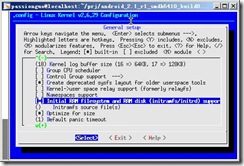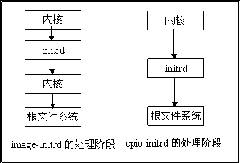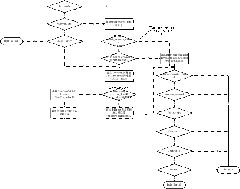Linux--根文件系统的挂载过程分析
前言:
本篇文章以S3C6410公版的Linux BSP和U-Boot来进行分析,文中全部提及的名词和数据都是以该环境为例,全部的代码流程也是以该环境为例来进行分析。哈哈。假设有不对或者不完好的地方,欢迎前来拍砖留言或者发邮件到guopeixin@126.com进行讨论,先行谢过。
简单的来说,根文件系统包含虚拟根文件系统和真实根文件系统。在Kernel启动的初始阶段,首先去创建虚拟的根文件系统,接下来再去调用do_mount来载入真正的文件系统,并将根文件系统切换到真正的文件系统,也即真实的文件系统。
一.什么是根文件系统
在传统的Windows机器上文件夹结构中,可能会包括C:或者D:盘,而他们一般就称之为特定逻辑磁盘的根文件夹。从文件系统的层面来说,每个分区都包括了一个根文件夹区,也即系统中存在多个根文件夹。
可是,在Linux系统中,文件夹结构与Windows上有较大的不同。系统中仅仅有一个根文件夹,路径是“/”,而其他的分区仅仅是挂载在根文件夹中的一个文件夹,如“/proc”和“system”等,这里的“/”就是Linux中的根文件夹。
相应根文件夹也就存在一个根文件夹文件系统的概念,我们能够将某一个分区挂载为根文件夹文件系统,如6410公版中就将mtdblk2挂载为根文件夹文件系统。程序中能够通过U-Boot给Kernel指定參数或者编译选项来指定,如眼下的开发板中就通过例如以下的编译选项来制定根文件夹文件系统:
|
CONFIG_CMDLINE="console=ttyS0,115200 mem=108M rdinit=/linuxrc root=/dev/mtdblock2" |
简单的来说,根文件夹文件系统就是一种文件夹结构,包含了Linux启动的时候所必须的一些文件夹结构和关键文件。
根文件系统有两种,一种是虚拟根文件系统,第二种是真实的根文件系统。普通情况下,会首先在虚拟的根文件系统中做一部分工作,然后切换到真实的根文件系统以下。
笼统的来说,虚拟的根文件系统包含三种类型,即Initramfs、cpio-initrd和image-initrd。
二.相关重要概念
1. Initrd
Initrd是在Linux中普遍採用的一种技术,就是由Bootloader载入的内存盘。在系统启动的过程中,首先会运行Initrd中的“某一个文件” 来完毕驱动模块载入的任务,第二阶段才会运行真正的根文件系统中的/sbin/init。这里提到的第一阶段是为第二阶段服务的,主要是用来载入根文件系统以及根文件系统存储介质的驱动程序。
资料中提到,存在多种类型的Initrd,实际应用中包含无Initrd、Linux Kernel和Initrd打包、Linux Kernel和Initrd分离以及RAMDisk Initrd。
眼下,手中项目採用的就是第四种策略。在系统启动的时候,U-Boot会将Linux Kernel和Rootfs载入到内存,并跳转到Linux Kernel的入口地址运行程序。这篇文章将側重对该种情况进行分析。
三.根文件系统载入代码分析
1. VFS的注冊
首先不得不从老掉牙的Linux系统的函数start_kernel()说起。函数start_kernel()中会去调用vfs_caches_init()来初始化VFS。
以下看一下函数vfs_caches_init ()的代码:
|
void __init vfs_caches_init(unsigned long mempages) { unsigned long reserve; /* Base hash sizes on available memory, with a reserve equal to 150% of current kernel size */ reserve = min((mempages - nr_free_pages()) * 3/2, mempages - 1); mempages -= reserve; names_cachep = kmem_cache_create("names_cache", PATH_MAX, 0, SLAB_HWCACHE_ALIGN|SLAB_PANIC, NULL); dcache_init(); inode_init(); files_init(mempages); [1] mnt_init(); bdev_cache_init(); chrdev_init(); } |
代码【1】:vfs_caches_init()中最重要的函数。函数mnt_init()会创建一个rootfs,这是个虚拟的rootfs,即内存文件系统,后面还会指向真实的文件系统。
接下来看一下函数mnt_init():
|
Void __init mnt_init(void) { unsigned u; int err; init_rwsem(&namespace_sem); mnt_cache = kmem_cache_create("mnt_cache", sizeof(struct vfsmount), 0, SLAB_HWCACHE_ALIGN | SLAB_PANIC, NULL); mount_hashtable = (struct list_head *)__get_free_page(GFP_ATOMIC); if (!mount_hashtable) panic("Failed to allocate mount hash table/n"); printk("Mount-cache hash table entries: %lu/n", HASH_SIZE); for (u = 0; u < HASH_SIZE; u++) INIT_LIST_HEAD(&mount_hashtable[u]); err = sysfs_init(); if (err) printk(KERN_WARNING "%s: sysfs_init error: %d/n", __func__, err); fs_kobj = kobject_create_and_add("fs", NULL); if (!fs_kobj) printk(KERN_WARNING "%s: kobj create error/n", __func__); [1] init_rootfs(); [2] init_mount_tree(); } |
代码[1]:创建虚拟根文件系统;
代码[2]:注冊根文件系统。
接下来看一下函数init_mount_tree()的代码:
|
static void __init init_mount_tree(void) { struct vfsmount *mnt; struct mnt_namespace *ns; struct path root; [1] mnt = do_kern_mount("rootfs", 0, "rootfs", NULL); if (IS_ERR(mnt)) panic("Can't create rootfs"); ns = kmalloc(sizeof(*ns), GFP_KERNEL); if (!ns) panic("Can't allocate initial namespace"); atomic_set(&ns->count, 1); INIT_LIST_HEAD(&ns->list); init_waitqueue_head(&ns->poll); ns->event = 0; list_add(&mnt->mnt_list, &ns->list); ns->root = mnt; mnt->mnt_ns = ns; init_task.nsproxy->mnt_ns = ns; get_mnt_ns(ns); root.mnt = ns->root; root.dentry = ns->root->mnt_root; set_fs_pwd(current->fs, &root); [2] set_fs_root(current->fs, &root); } |
代码[1]:创建虚拟文件系统;
代码[2]:将当前的文件系统配置为根文件系统。
可能有人会问,为什么不直接把真实的文件系统配置为根文件系统?
答案非常easy,内核中没有根文件系统的设备驱动,如USB等存放根文件系统的设备驱动,并且即便你将根文件系统的设备驱动编译到内核中,此时它们还尚未载入,事实上全部的Driver是由在后面的Kernel_Init线程进行载入。所以须要CPIO Initrd、Initrd和RAMDisk Initrd。另外,我们的Root设备都是以设备文件的方式指定的,假设没有根文件系统,设备文件怎么可能存在呢?
2. VFS的挂载
接下来,Kernel_Start会去调用rest_init()并会去创建系统中的第一个进程Kernel_Init,并由其调用全部模块的初始化函数,当中ROOTFS的初始化函数也在这个期间被调用。
函数rest_init代码例如以下:
|
/* * We need to finalize in a non-__init function or else race conditions * between the root thread and the init thread may cause start_kernel to * be reaped by free_initmem before the root thread has proceeded to * cpu_idle. * * gcc-3.4 accidentally inlines this function, so use noinline. */ static noinline void __init_refok rest_init(void) __releases(kernel_lock) { int pid; kernel_thread(kernel_init, NULL, CLONE_FS | CLONE_SIGHAND); numa_default_policy(); pid = kernel_thread(kthreadd, NULL, CLONE_FS | CLONE_FILES); kthreadd_task = find_task_by_pid_ns(pid, &init_pid_ns); unlock_kernel(); /* * The boot idle thread must execute schedule() * at least once to get things moving: */ init_idle_bootup_task(current); rcu_scheduler_starting(); preempt_enable_no_resched(); schedule(); preempt_disable(); /* Call into cpu_idle with preempt disabled */ cpu_idle(); } |
函数Kernel_Init代码例如以下:
|
static int __init kernel_init(void * unused) { lock_kernel(); /* * init can run on any cpu. */ set_cpus_allowed_ptr(current, CPU_MASK_ALL_PTR); /* * Tell the world that we're going to be the grim * reaper of innocent orphaned children. * * We don't want people to have to make incorrect * assumptions about where in the task array this * can be found. */ init_pid_ns.child_reaper = current; cad_pid = task_pid(current); smp_prepare_cpus(setup_max_cpus); do_pre_smp_initcalls(); start_boot_trace(); smp_init(); sched_init_smp(); cpuset_init_smp(); [1] do_basic_setup(); /* * check if there is an early userspace init. If yes, let it do all * the work */ [2] if (!ramdisk_execute_command) ramdisk_execute_command = "/init"; [3] if (sys_access((const char __user *) ramdisk_execute_command, 0) != 0) { ramdisk_execute_command = NULL; prepare_namespace(); } /* * Ok, we have completed the initial bootup, and * we're essentially up and running. Get rid of the * initmem segments and start the user-mode stuff.. */ init_post(); return 0; } |
代码[1]:函数do_basic_setup()调用全部模块的初始化函数,包含initramfs的初始化函数populate_rootfs。这部分代码在init/initramfs.c以下,函数populate_rootfs通过例如以下方式导出:
|
rootfs_initcall(populate_rootfs); |
代码[2]:ramdisk_execute_command值通过“rdinit=”指定,假设未指定,则採用默认的值/init。
代码[3]:检查根文件系统中是否存在文件ramdisk_execute_command,假设存在的话则运行init_post(),否则运行prepare_namespace()挂载根文件系统。
须要特别指出的是initramfs.c模块的入口函数populate_rootfs()是否运行取决于Kernel的编译选项。參照linux/init文件夹下的makefile文件,例如以下:
|
# # Makefile for the linux kernel. # obj-y := main.o version.o mounts.o ifneq ($(CONFIG_BLK_DEV_INITRD),y) obj-y += noinitramfs.o else obj-$(CONFIG_BLK_DEV_INITRD) += initramfs.o endif obj-$(CONFIG_GENERIC_CALIBRATE_DELAY) += calibrate.o mounts-y := do_mounts.o mounts-$(CONFIG_BLK_DEV_RAM) += do_mounts_rd.o mounts-$(CONFIG_BLK_DEV_INITRD) += do_mounts_initrd.o mounts-$(CONFIG_BLK_DEV_MD) += do_mounts_md.o |
主要完毕Initrd的检測工作,检查出是CPIO Initrd还是Initramfs还是Image-Initrd还是须要在编译的时候做例如以下的配置(General setupàInitramfs/initrd support):

该函数的代码例如以下:
|
static int __init populate_rootfs(void) { [1] char *err = unpack_to_rootfs(__initramfs_start, __initramfs_end - __initramfs_start, 0); if (err) panic(err); [2] if (initrd_start) { #ifdef CONFIG_BLK_DEV_RAM int fd; printk(KERN_INFO "checking if image is initramfs..."); [3] err = unpack_to_rootfs((char *)initrd_start, initrd_end - initrd_start, 1); if (!err) { printk(" it is/n"); unpack_to_rootfs((char *)initrd_start, initrd_end - initrd_start, 0); free_initrd(); return 0; } printk("it isn't (%s); looks like an initrd/n", err); [4] fd = sys_open("/initrd.image", O_WRONLY|O_CREAT, 0700); if (fd >= 0) { [5] sys_write(fd, (char *)initrd_start, initrd_end - initrd_start); sys_close(fd); [6] free_initrd(); } #else printk(KERN_INFO "Unpacking initramfs..."); [7] err = unpack_to_rootfs((char *)initrd_start, initrd_end - initrd_start, 0); if (err) panic(err); printk(" done/n"); free_initrd(); #endif } return 0; } |
代码[1]:unpack_to_rootfs顾名思义,就是解压包到rootfs,其具有两个功能,一个是检測是否是属于cpio包,另外一个就是解压cpio包,通过最后一个參数进行控制。1:检測,0:解压。事实上,Initramfs也是压缩过后的CPIO文件。
资料中提到,Linux2.5中開始引入initramfs,在Linux2.6中一定存在,并且编译的时候通过连接脚本arch/arm/kernel/vmlinux.lds将其编译到__initramfs_start~__initramfs_end,运行完unpack_to_rootfs后将被复制到根文件夹。
代码[2]:推断是否载入了Initrd,不管对于那种格式的Initrd,即不管是CPIO-Initrd还是Image-Initrd,U-Boot都会将其复制到initrd_start。当然了,假设是initramfs的情况下,该值肯定为空了。
代码[3]:推断载入的是不是CPIO-Initrd。
通过在这里主要用于检測,假设是编译到Linux Kernel的CPIO Initrd,__initramfs_end - __initramfs_start应该是大于零的,否则为零,事实上也就是通过这里来推断是否为CPIO Initrd。
代码[4]:假设不是CPIO-Initrd,则就是Image-Initrd,将其内容保存到文件/initrd.image中。在根文件系统中创建文件/initrd.image。
代码[5]:这里是对Image-Initrd提供支持的,将内存中的initrd赋值到initrd.image中,以释放内存空间。
代码[6]:释放Initrd所占用的内存空间。
另外,假设要支持Image-Initrd的话,必需要配置CONFIG_BLK_DEV_RAM,配置的方法上面已经讲过。
以下接着来分析函数kernel_init
|
static int __init kernel_init(void * unused) { … do_basic_setup(); /* * check if there is an early userspace init. If yes, let it do all * the work */ if (!ramdisk_execute_command) ramdisk_execute_command = "/init"; [1] if (sys_access((const char __user *) ramdisk_execute_command, 0) != 0) { ramdisk_execute_command = NULL; prepare_namespace(); } /* * Ok, we have completed the initial bootup, and * we're essentially up and running. Get rid of the * initmem segments and start the user-mode stuff.. */ init_post(); return 0; } |
代码[1]:前面在对函数populate_rootfs进行分析的时候已经知道,对于initramfs和cpio-initrd的情况,都会将文件系统(事实上是一个VFS)解压到根文件系统。假设虚拟文件系统中存在ramdisk_execute_command指定的文件则直接转向init_post()来运行,否则运行函数prepare_namespace()。
3. 根文件系统的挂载
从上面的代码分析中知道,对于Image-Initrd或者VFS(即InitRamfs或者CPIO-Initrd)中不存在文件ramdisk_execute_command的情况,则运行prepare_namespace()。
接下来看一下函数prepare_namespace()的代码:
|
/* * Prepare the namespace - decide what/where to mount, load ramdisks, etc. */ void __init prepare_namespace(void) { int is_floppy; [1] if (root_delay) { printk(KERN_INFO "Waiting %dsec before mounting root device.../n", root_delay); ssleep(root_delay); } /* * wait for the known devices to complete their probing * * Note: this is a potential source of long boot delays. * For example, it is not atypical to wait 5 seconds here * for the touchpad of a laptop to initialize. */ [2] wait_for_device_probe(); md_run_setup(); [3] if (saved_root_name[0]) { root_device_name = saved_root_name; if (!strncmp(root_device_name, "mtd", 3) || !strncmp(root_device_name, "ubi", 3)) { [4] mount_block_root(root_device_name, root_mountflags); goto out; } [5] ROOT_DEV = name_to_dev_t(root_device_name); if (strncmp(root_device_name, "/dev/", 5) == 0) root_device_name += 5; } [6] if (initrd_load()) goto out; [7] /* wait for any asynchronous scanning to complete */ if ((ROOT_DEV == 0) && root_wait) { printk(KERN_INFO "Waiting for root device %s.../n", saved_root_name); while (driver_probe_done() != 0 || (ROOT_DEV = name_to_dev_t(saved_root_name)) == 0) msleep(100); async_synchronize_full(); } is_floppy = MAJOR(ROOT_DEV) == FLOPPY_MAJOR; if (is_floppy && rd_doload && rd_load_disk(0)) ROOT_DEV = Root_RAM0; mount_root(); out: [9] sys_mount(".", "/", NULL, MS_MOVE, NULL); [10] sys_chroot("."); } |
代码[1]:资料中提到,对于将根文件系统存放到USB或者SCSI设备上的情况,Kernel须要等待这些耗费时间比較久的设备驱动载入完成,所以这里存在一个Delay。
代码[2]:从字面的意思来看,这里也是来等待根文件系统所在的设备探測函数的完毕。
代码[3]:參数saved_root_name存放的是Kernel參数root=所指定的设备文件,这点不再赘述,能够參照代码。
代码[4]:依照资料中的解释,这里相当于将saved_root_nam指定的设备进行载入。如以下传递给内核的command line:
|
CONFIG_CMDLINE="console=ttyS0,115200 mem=108M rdinit=/linuxrc root=/dev/mtdblock2" |
实际上就是载入/dev/mtdblock2。
代码[5]:參数ROOT_DEV存放设备节点号。
代码[6]:挂载initrd,这里进行的操作相当的复杂,能够參照兴许关于该函数的详解。
代码[7]:假设指定mount_initrd为true,即没有指定在函数initrd_load中mount的话,则在这里又一次realfs的mount操作。
代码[9]:将挂载点从当前文件夹(实际当前的文件夹在mount_root中或者在mount_block_root中指定)移到根文件夹。对于上面的command line的话,当前的文件夹就是/dev/mtdblock2。
代码[10]:将当前文件夹当作系统的根文件夹,至此虚拟系统根文件夹文件系统切换到了实际的根文件夹文件系统。
接下来看一下函数initrd_load()的代码:
|
int __init initrd_load(void) { [1] if (mount_initrd) { [2] create_dev("/dev/ram", Root_RAM0); /* * Load the initrd data into /dev/ram0. Execute it as initrd * unless /dev/ram0 is supposed to be our actual root device, * in that case the ram disk is just set up here, and gets * mounted in the normal path. */ [3] if (rd_load_image("/initrd.image") && ROOT_DEV != Root_RAM0) { sys_unlink("/initrd.image"); [4] handle_initrd(); return 1; } } sys_unlink("/initrd.image"); return 0; } |
代码[1]:能够通过Kernel的參数“noinitrd“来配置mount_initrd的值,默觉得1,非常少看到有项目区配置该值,所以普通情况下,mount_initrd的值应该为1;
代码[2]:创建一个Root_RAM0的设备节点/dev/ram;
代码[3]:假设根文件设备号不是Root_RAM0则程序就会运行代码[4],换句话说,就是给内核指定的參数不是/dev/ram,比如上面指定的/dev/mtdblock2设备节点肯定就不是Root_RAM0。
另外这行代码还将文件initrd.image释放到节点/dev/ram0,也就是相应image-initrd的操作。
代码[4]:函数handle_initrd主要功能是运行Initrd中的linuxrc文件,而且将realfs的根文件夹设置为当前文件夹。事实上前面也已经提到了,这些操作仅仅对image-cpio的情况下才会去运行。
函数handle_initrd的代码例如以下:
|
static void __init handle_initrd(void) { int error; int pid; [1] real_root_dev = new_encode_dev(ROOT_DEV); [2] create_dev("/dev/root.old", Root_RAM0); /* mount initrd on rootfs' /root */ mount_block_root("/dev/root.old", root_mountflags & ~MS_RDONLY); [3] sys_mkdir("/old", 0700); root_fd = sys_open("/", 0, 0); old_fd = sys_open("/old", 0, 0); /* move initrd over / and chdir/chroot in initrd root */ [4] sys_chdir("/root"); sys_mount(".", "/", NULL, MS_MOVE, NULL); sys_chroot("."); /* * In case that a resume from disk is carried out by linuxrc or one of * its children, we need to tell the freezer not to wait for us. */ current->flags |= PF_FREEZER_SKIP; [5] pid = kernel_thread(do_linuxrc, "/linuxrc", SIGCHLD); if (pid > 0) while (pid != sys_wait4(-1, NULL, 0, NULL)) yield(); current->flags &= ~PF_FREEZER_SKIP; /* move initrd to rootfs' /old */ sys_fchdir(old_fd); sys_mount("/", ".", NULL, MS_MOVE, NULL); /* switch root and cwd back to / of rootfs */ [6] sys_fchdir(root_fd); sys_chroot("."); sys_close(old_fd); sys_close(root_fd); [7] if (new_decode_dev(real_root_dev) == Root_RAM0) { sys_chdir("/old"); return; } [8] ROOT_DEV = new_decode_dev(real_root_dev); mount_root(); [9] printk(KERN_NOTICE "Trying to move old root to /initrd ... "); error = sys_mount("/old", "/root/initrd", NULL, MS_MOVE, NULL); if (!error) printk("okay/n"); else { int fd = sys_open("/dev/root.old", O_RDWR, 0); if (error == -ENOENT) printk("/initrd does not exist. Ignored./n"); else printk("failed/n"); printk(KERN_NOTICE "Unmounting old root/n"); sys_umount("/old", MNT_DETACH); printk(KERN_NOTICE "Trying to free ramdisk memory ... "); if (fd < 0) { error = fd; } else { error = sys_ioctl(fd, BLKFLSBUF, 0); sys_close(fd); } printk(!error ? "okay/n" : "failed/n"); } } |
代码[1]:real_root_dev为一个全局变量,用来保存realfs的设备号。
代码[2]:调用mount_block_root将realfs载入到VFS的/root下。
代码[3]:提取rootfs的根文件描写叙述符并将其保存到root_fd,资料中提及其用处就是在兴许调用sys_chroot到initrd的文件系统后,处理完init请求后,还可以再次切回到rootfs,这一点在一份IBM官方有关cpio-initrd和image-initrd的运行流程图中可以看到,例如以下:

代码[4]:sys_chroot到initrd文件系统,前面已经挂载initrd到VFS的root文件夹下;
代码[5]:运行initrd中的linuxrc,并等待运行结束;
代码[6]:initrd运行结束后,切回到rootfs,不知道为什么直接用节点切呢?
代码[7]:假设real_root_dev直接配置为Root_RAM0,也即直接使用直接使用initrd作为realfs,改变当前文件夹到initrd中,并直接返回。
代码[8]:运行完Linuxrc后,realfs已经确定,则调用mount_root将realfs挂载到VFS的/root文件夹下,并将当前的文件夹配置为VFS的/root。
代码[9]:收尾的工作,比如释放内存等。
4. 真实根文件系统挂载后的操作
以下回过头来再看上面提到的init_post,该函数实际上是在Kernel_init中最后运行的函数。其代码例如以下:
|
/* This is a non __init function. Force it to be noinline otherwise gcc * makes it inline to init() and it becomes part of init.text section */ static noinline int init_post(void) { /* need to finish all async __init code before freeing the memory */ async_synchronize_full(); free_initmem(); unlock_kernel(); mark_rodata_ro(); system_state = SYSTEM_RUNNING; numa_default_policy(); if (sys_open((const char __user *) "/dev/console", O_RDWR, 0) < 0) printk(KERN_WARNING "Warning: unable to open an initial console./n"); (void) sys_dup(0); (void) sys_dup(0); current->signal->flags |= SIGNAL_UNKILLABLE; if (ramdisk_execute_command) { run_init_process(ramdisk_execute_command); printk(KERN_WARNING "Failed to execute %s/n", ramdisk_execute_command); } /* * We try each of these until one succeeds. * * The Bourne shell can be used instead of init if we are * trying to recover a really broken machine. */ if (execute_command) { run_init_process(execute_command); printk(KERN_WARNING "Failed to execute %s. Attempting " "defaults.../n", execute_command); } run_init_process("/sbin/init"); run_init_process("/etc/init"); run_init_process("/bin/init"); run_init_process("/bin/sh"); panic("No init found. Try passing init= option to kernel."); } |
能够看到,在该函数的最后,以此会去搜索文件并运行ramdisk_execute_command、execute_command、/sbin/init、/etc/init、/bin/init和/bin/sh,假设发现这些文件均不存在的话,则通过panic输出错误命令,并将当前的系统Halt在那里。
四.RootFS载入过程流程图描写叙述
具体的流程图例如以下:

(完)
[p1]之所以称之为“某一个文件”,是由于这里文件的名字由于操作系统的版本号不同而不同
Linux--根文件系统的挂载过程分析的更多相关文章
- linux根文件系统的挂载过程详解
一:前言 前段时间在编译kernel的时候发现rootfs挂载不上.相同的root选项设置旧版的image却可以.为了彻底解决这个问题.研究了一下rootfs的挂载过程.特总结如下,希望能给这部份知识 ...
- linux根文件系统 /etc/resolv.conf 文件详解
Linux根文件系统/etc/resolv.conf文件,它是DNS客户机配置文件,用于设置DNS服务器的IP地址及DNS域名,还包含了主机的域名搜索顺序.该文件是由域名解析器(resolver,以恶 ...
- linux根文件系统制作
在嵌入式中移植的内核下载到开发板上,是没有办法真正的启动Linux操作系统的,会出现无法加载文件系统的错误. 那么根文件系统在系统启动中到底是什么时候挂载的呢?先将/dev/ram0挂载,而后执行/l ...
- Linux根文件系统的制作
转载:http://www.cnblogs.com/hnrainll/archive/2011/06/09/2076655.html 1. 根文件系统 文件系统是包括在一个磁盘(包括光盘.软盘.闪盘及 ...
- Linux 根文件系统的制作
一.建立根文件系统目录与文件 1. 创建目录 #mkdir rootfs #cd rootfs #mkdir bin dev etc lib proc sbin sys usr mnt tmp var ...
- Linux根文件系统
root :文件系统是文件系统的顶级目录.它必须包含在挂载其它文件系统前需要用来启动 Linux 系统的全部文件.它必须包含需要用来启动剩余文件系统的全部可执行文件和库.文件系统启动以后,所有其他文件 ...
- 使用BusyBox制作linux根文件系统(CramFS+mdev)
转:http://www.360doc.com/content/10/0428/11/496343_25245348.shtml 操作系统:Ubuntu9.04 内核版本:linux-2.6.24.7 ...
- Linux根文件系统和目录结构及bash特性1
Linux文件系统: 内核并不真正负责具体的工作,这些工作是应用程序来负责的 Linux glibc 程序的编译方式: 动态链接式编译: 静态链接式编译: ...
- 基于mini2440嵌入式Linux根文件系统制作(Initramfs和nfs两种跟文件系统)
嵌入式系统由三部分构成: 1.bootoader---bootparameters---2.kernel 3.Root-filesysytem 一个内核可以挂载多个文件系统,但是有一个根文件系统所以叫 ...
随机推荐
- redhat 6.3 64位安装中文输入法全过程记录
首先,修改/etc/profile文件,在末尾增加两行: export LC_ALL="zh_CN.UTF-8" export LANG="zh_CN.UTF-8&quo ...
- DevC++ 工程没有调试信息的解决办法
DevC++4.9.9.2中,按 F8 开始调试.提示信息为:工程没有调试信息,您想打开工程的调试选项并重新生成吗?选择是后,再按F8,仍旧是这个信息.什么原因呢? 按照帮助,Frequently A ...
- 推荐一款JavaScript日历控件:kimsoft-jscalendar
一.什么是 kimsoft-jscalendar 一个简洁的avaScript日历控件,可在Java Web项目,.NET Web 项目中使用 二.kimsoft-jscalendar 有什么 ...
- error LNK1104: 无法打开文件“libboost_thread-vc140-mt-gd-1_61.lib”
error LNK1104: 无法打开文件“libboost_thread-vc140-mt-gd-1_61.lib” 调试->你的项目属性 配置属性->VC++目录 包含目录 D:\bo ...
- Android工程师面试准备知识点
听+7哥说,把下面的全弄懂,面试必过,所以我就试着去把所有题目补充了一下,各位能耐的网友们,如果有吐槽或者补充的尽管给我留言,在这里谢过大家了. 1. android的多线程如何通信 答:Andr ...
- python中pip的使用和安装
Ubuntu下安装pip的方法 安装pip的方法: Install pip and virtualenv for Ubuntu 10.10 Maverick and newer $ sudo ...
- leetcode_question_130 Surrounded Regions
Given a 2D board containing 'X' and 'O', capture all regions surrounded by 'X'. A region is captured ...
- HTML及CSS常用颜色英文词汇
黑色 银色 灰色 白色 茶色 红色 紫色 紫红 black silver gray white maroon red purple fuchsia #000000 #C0C0C0 #808080 #F ...
- WampServer2.5的XDebug调试不成功的原因
WampServer2.5的php.ini文件位置很奇妙,除了在“wamp\bin\php\php5.5.12”目录下有一个外,“wamp\bin\apache\apache2.4.9\bin”目录下 ...
- javascript 正则表达式代码
正则表达式用于字符串处理.表单验证等场合,实用高效.现将一些常用的表达式收集于此,以备不时之需. 匹配中文字符的正则表达式: [\u4e00-\u9fa5] 评注:匹配中文还真是个头疼的事,有了这个表 ...
